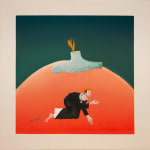





Piers Alsop British , b. 1984
Agony in the Sculpture Garden, 2020
Oil on canvas.
130 x 130 cm
51 1/8 x 51 1/8 in
51 1/8 x 51 1/8 in
Further images
An appropriation of an appropriation. The idea for this allusive painting came about after looking at Gauguin’s self-portrait titled Christ in the Olive Garden, 1898, a painting in which Gauguin...
An appropriation of an appropriation. The idea for this allusive painting came about after looking at Gauguin’s self-portrait titled Christ in the Olive Garden, 1898, a painting in which Gauguin identifies his suffering as an artist with that of Christ's betrayal. The cliched trope of the suffering artist is, in Alsop’s version, reduced to a pose – one which marks a resemblance to Bruce Mclean’s Pose work for plinths I, 1971 – complete with a cigarette in one hand and an olive on a cocktail stick in the other: clear references to the olive garden of Gethsemane and the semaphore of religious painting. The sculpture atop the knoll, meanwhile, bears a likeness to one of Anselm Kiefer’s beached rusting hulks.
This painting is a typical example of the way in which Alsop uses humour to explore a broader interest in what Victor Frankl described as man’s primary motivational force: a search for meaning. With the decline of the church in the west, galleries seem to have usurped their role as temple and our use of them – usually on Sundays – mimics the religious rituals of bygone eras. Piers explores this idea by blending a traditional religious scene from western art history with one of our current local traditions of placing sculptures on a lawn.
This painting is a typical example of the way in which Alsop uses humour to explore a broader interest in what Victor Frankl described as man’s primary motivational force: a search for meaning. With the decline of the church in the west, galleries seem to have usurped their role as temple and our use of them – usually on Sundays – mimics the religious rituals of bygone eras. Piers explores this idea by blending a traditional religious scene from western art history with one of our current local traditions of placing sculptures on a lawn.
20
of
20






